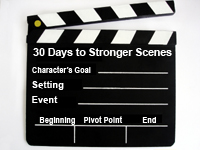When to use Narrative and when to use Scenes
 30 Days to a Stronger Scene Table of Contents
30 Days to a Stronger Scene Table of Contents
This is the great Show-Don’t-Tell debate. When should you take the time in a story to present a fully developed scene?
To understand this, let’s look at options.
Scene. First, is the fully developed scene that we discussed in SCENE 2.
Narrative summary. For a narrative summary, you leave out many of the details and just briefly tell events. This feels like someone just giving you highlights and may not include all the elements of a scene. It’s just getting you from scene to scene, while making sure you don’t miss anything important. It’s TELLING. So, don’t use it often. But when you want to compress the time line, skip briefly over events or speed up things, use a narrative summary.
Transitions. Another section of text might be a quick transition. It may have action, dialogue, thought or emotion, but it’s purpose is to get you from point A to point B. Often it’s narrative summary, but it can be much shorter. For example, you might start a follow-up scene like this: “Later, she went. . . “ Later is the transition and it’s a single word.
Featured Today in Fiction Notes Stores
Narrative summary and transition are important in moving a story forward. Well-developed scenes, though, are the meat of the story and where you’ll camp. You need all of these in your tool box, but you need to know when to pull out which.
